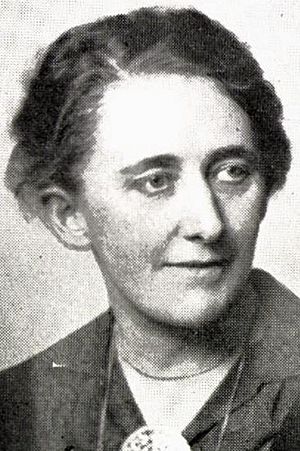Gudrun Ruud facts for kids
Quick facts for kids
Gudrun Ruud
|
|
|---|---|
 |
|
| Born | 14 April 1882 Oslo
|
| Died | 30 December 1958 (aged 76) |
| Awards | Norwegian Academy |
| Academic background | |
| Alma mater | University of Oslo |
| Influences | Kristine Bonnevie Hans Spemann Ross G. Harrison |
| Academic work | |
| Institutions | Zoological Laboratory |
| Main interests | zoologist |
| Notable ideas | axolotl |
Gudrun Marie Ruud (born April 14, 1882 – died December 31, 1958) was a Norwegian scientist who studied animals. She was also a teacher. She is famous for her important research on how animal embryos develop. She did many experiments using salamanders.
Contents
Early Life and Education
Gudrun Ruud was born in Oslo (then called Christiania). She was the youngest daughter of a successful merchant. She had a happy childhood on a large property with many animals. From a young age, she loved the birds, animals, and plants she saw during her holidays.
She first trained to be a teacher. Later, she decided to study science at the University of Oslo. She graduated in 1913. To help pay for her studies, she worked as an assistant at the Zoological Laboratory starting in 1910.
Her Work as a Scientist
Because of her hard work at the laboratory, Gudrun Ruud soon became a key helper for Kristine Bonnevie. Bonnevie was a famous zoologist. Ruud kept this important role for many years. In 1916, she became an associate professor at the laboratory. She held this title until she retired in 1948.
Ruud's main research was in embryology. This is the study of how living things develop from a single cell into a complex organism. She focused on how different cells grow in an embryo.
Studying Embryo Development
From 1916 to 1920, Ruud traveled to Berlin many times. There, she worked with Hans Spemann, another important scientist. In 1925, she went to the United States. She worked with Ross G. Harrison at Yale University. They did experiments on the axolotl, which is a type of Mexican salamander.
When she returned to Oslo two years later, she made an amazing discovery. She found that an arm could grow from an unexpected place on an axolotl's body! This showed how flexible and amazing animal development can be.
Teaching and Later Life
Teaching was a very important part of Gudrun Ruud's work. She helped Kristine Bonnevie teach zoology courses. These courses covered topics like anatomy (the study of body structure), embryology, and cytology (the study of cells).
Ruud also led a one-year practical course for students. She gave lectures on histology, which is the study of tissues. She taught students how to use a microscope. Ruud also helped with practical zoology courses at the university's biological station in Drøbak. These courses focused on the animals living in the fjord.
In 1932, Gudrun Ruud became a member of the Norwegian Academy of Science and Letters. This is a very respected group of scientists. She passed away peacefully on December 31, 1958.

